Hokepoints: Would Bill Walsh Draft These DBs?

left: Bryan Fuller
Earlier this offseason I stumbled onto an old article where Bill Walsh wrote what qualities he looks for when drafting various positions. Meant to be a one-off on the offense, I took requests for a defensive version and broke it up into D-Line, linebackers, and now, finally, the defensive backs. The idea is since the coaching staff is building a "pro-style" team with principles more akin to the Walsh ideal that dominates the pros than the collegiate evaluations made on scouting sites and the like, we shall re-scout the 2013 roster for Walsh-approved attributes.
Since coverages have changed the most since Walsh's day—a reaction to the spread—this is probably the least valuable of the series. To bring it back on point, I've gone off the page a little bit to note some of the attributes that NFL defensive coaches are looking for nowadays, and what those changes mean.
Strong Safety
Plankamalu / Shazorvacs/ M-Rob if all quarterbacks were Brian Cleary
Walsh Says: 6'3/215. Now hold your horses before going all "SHAZOR?!?" on me—I'm making a point: The type of player you have at safety depends on the type of system you want to run and the type of player you have everywhere else. If you're going to be playing more odd coverages (cover 1, cover 3) then you want your strong safety to be more of a run support guy, in many ways a fourth linebacker. If your base coverage is even (cover 2, cover 4) the strong and weak safeties will be more similar:
"There are other systems of defense where both safeties play a two-deep coverage and only occasionally come out of the middle to support the run. They basically play the ball in the air, the middle of the field and the sidelines. When you do that, then the stress is on the cornerback to be the support man.
So you must keep in mind these various philosophies when considering what types of cornerbacks and safeties you want to put together in forming a defensive secondary."
The attributes of your defensive backs should be complementary. Here's what Walsh is getting at: your backfield has to be able to defend the pass first and the run second. And here's the key: the more you can trust one player to handle coverage without help, 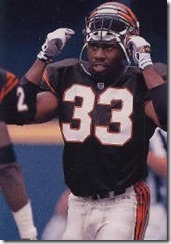 the more you can stock up on extra run defense with the other guys. If your backfield already has plenty of coverage, you can have a strong man:
the more you can stock up on extra run defense with the other guys. If your backfield already has plenty of coverage, you can have a strong man:
"The strong safety is historically the support man. He must have some of the traits you look for in a linebacker. In fact there have been some hybrid players in that position. Cincinnati had David Fulcher [right], who was as big as some linebackers but could function also as a safety. The Bengals moved him weak and strong, inside and outside and he became that extra man that the offensive run game had to account for but often could not block.
…
"But the typical strong safety is someone who can hit and stop people and respond spontaneously and go to the ball. Naturally, the more coverage talent the man has the more you can line him up on anybody."
Today, defensive coordinators sit on porches, remember when you could play a guy like Fulcher, and say "those were the days." The epitome of this type of safety is former Buckeye Doug Plank, who defined his position to such a degree that the defensive system itself was named for his number (46).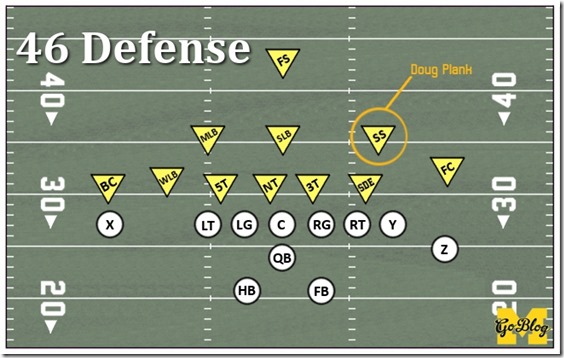
It's also called the "Bear" defense because it was the Bears
This defense was at the height of its popularity when Walsh joined the 49ers in 1979, and it was this defense his model passing concepts shredded. The defense played to Plank's strengths as an overly aggressive, hard-hitting run stopper with some coverage skills. The SAM linebacker in today's anti-spread sets (e.g. the 3-3-5's "Spur") is a closer analogue to the Plank-style player than the modern strong safety, with the key difference being that, as a safety, you couldn't put a blocker on a 46 without removing one from a lineman or linebacker, meaning the SS could flow cleanly to the point of attack and wrack up ridiculous tackle numbers.
College teams loved this, since passing quarterbacks were hard to come by and the big boys were running three yards and a cloud of dust (and later the option). A lot of cool names for linebacker-safeties were passed down from this period, such as the "Wolf" on Bo's teams, or the "Star" (names which today are coming out of retirement for the nickel-SAM hybrid position in base 4-2-5 anti-spread defenses).
Walsh's Favorite Wolverine: Why does a mid-'70s response to off-tackle NFL running games matter to a collegiate defense in 2013? Well because we have a really good free safety, and play tight end-heavy outfits this year in UConn (T.J. Weist, a rare member of the Gary Moeller coaching tree, is taking over there), Penn State, Michigan State, and Iowa, with the outside possibility of a Wisconsin if we make it to the conference championship. Also because the coaches have been subtly putting safety-like objects (Woolfolk, Gordon, and now Dymonte Thomas) at nickel, and recruiting a few linebacker-sized safeties.
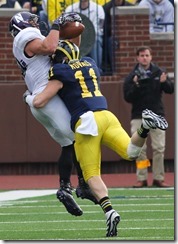 I don't know what he'd think of Kovacs. We loved him, but Jordan had two weaknesses: 1) his lack of overall athleticism made exploitable if left in wide coverage (see: his abusing by Ace Sanders on the last play of the Outback Bowl, and the utter disaster that was GERG's attempt to play Kovacs as the free safety in 2009), and 2) his lack of size made him blockable if a lead blocker could get to him (see: bad things happening whenever Mouton abandoned contain).
I don't know what he'd think of Kovacs. We loved him, but Jordan had two weaknesses: 1) his lack of overall athleticism made exploitable if left in wide coverage (see: his abusing by Ace Sanders on the last play of the Outback Bowl, and the utter disaster that was GERG's attempt to play Kovacs as the free safety in 2009), and 2) his lack of size made him blockable if a lead blocker could get to him (see: bad things happening whenever Mouton abandoned contain).
He would have loved Ernest Shazor, a knife blade listed at 6'4/226 with a scatback's acceleration who loved nothing better than demonstrating the force equation. Brian calls Shazor "the most overrated Michigan player of the decade" because he has to live with the bolded subconscious of UFR, and nothing pisses off a figment of a blogger's imagination like a safety who gives up a big play in coverage.
Here's the point: the ideal safety would be a dude with the size and stopping power to pop a lead blocker and make the tackle or lay out a guy like Shazor, read and react like Kovacs, and cover like Charles Woodson. That human doesn't exist. A combo of epic athleticism with plus headiness and serviceable tackling and size equals Ed Reed or Sean Taylor. Epic headiness with plus size and serviceable everything else nets you Doug Plank, with plus athleticism: Ronnie Lott, Troy Polamalu or Rodney Harrison. The trick is to have epic everything between your safeties; for strongside then it's not Ernest Shazor or Jordan Kovacs; it's SHAZORVACS!
What to look for in a Scouting Report: At either safety position, instincts rate highly and speed after that (less so for the strongside). You're looking to first make sure you have enough coverage in the entire backfield, and once you do you can use this position to stock up on linebacker traits: tackling, size, taking on blockers, personal contribution to local seismic activity, that sort of stuff.
What you can learn on film: Everyone loves those bone-jarring hits and coaches are more than happy to put them in a recruiting video, but not all hits are created equal. Sometimes they're generated by another defender cutting off the lead blocker, other times it's your guy reading the play so early he can go all-out on the hit. More important is what happens to the ballcarrier: he needs to go down. Safeties are going to be left in space, and making that tackle is more important than making the offensive player wish he'd never met this oblong brown thing.
What could signal bust potential: Remember you want a safety, not a horse, i.e. overrating the secondary, linebacker-y attributes and expecting the rest to come along. Adequate coverage and good instincts need to be there or else this guy is just a platoon player. "May be a linebacker on the next level" is a red flag, unless he actually becomes a linebacker. Brandon Smith's recruiting profile is instructive.
It's usually good policy to discount ESPN's opinion when it's in wild disagreement with the other services, but here I tend to give their rip job ($, "he's not a fast-twitch athlete and lacks explosive quickness and speed"; "Takes too long to reach top speed"; "He can be late, takes false steps and doesn't see things happen quickly enough") some credence. Reasons:
- Rivals started off very high on him, ranking him around #50, but steadily dropped him as the year progressed despite his status as a high-profile uncommitted player.
- Despite all the guru accolades Michigan's main competitors were Rutgers and South Carolina; other offers came from Maryland, NC State, Wisconsin and West Virginia. He wanted offers from Florida and Ohio State which never came.
- You always risk looking like a tool when you rely on your super awesome scouting skills and six plays on youtube to discern a kid's fate, but... yeah, I didn't think he was all that.
The guy left in a huff after they tried to wring the last bit of value out of him as a Doug Plank-like extra linebacker vs. Wisconsin, and Wisconsin ground us to dust, but then Smith was a high school quarterback whose development as a defender had to come almost entirely from the Rodriguez-era coaching staff. Anyway you've seen this again and again: rave reviews for the guy's "frame" and a profundity of attributes that would make him seem a really nice horse, combined with not nearly enough "makes plays." First have all of the safety stuff: can read and react, cover, and tackle in space. Then care about the size.
How our guys compare: Jarrod Wilson (6'2/196) remains my favorite to start at this spot because he is adequate (not yet plus) in coverage and the other guys aren't. Like the Jamar Adams he reminds me of, Wilson doesn't stand out in any category but doesn't have any major holes in his game other than being young.
The other leading candidate is Marvin Robinson who scares the hell out of me. He was a big-time recruit early in the process thanks to apparently having an early growth spurt, and his profile was filled with horsey metaphors. The same player still hangs on that frame (he arrived at 203 and never deviated more than 3 lbs from that) and hopes for him hang on the comparative competence in coaching plus the fact that being behind Jordan Kovacs is a perfectly reasonable excuse for not seeing the field earlier.
The redshirt freshmen at this position are stiff and linebacker-ish with instincts, more Plank than Polamalu. Jeremy Clark is all of 6'4/201 and did an okay job against the run in the Spring Game I covered in this space a few weeks ago, but lacks speed. Allen Gant also had instincts praised as a recruit, but also lacks the kind of athleticism and would at best develop into a slightly bigger and less heady Kovacs. If going forward Michigan can develop a superstar at the other safety spot or with a corner, they might be able to Plank it with one of these guys—when Woodson gave us that opportunity in '97, Daydrion Taylor and Tommy Hendricks went ham.
Thomas Gordon is super-instinctive and would be a perfect fit here except he's needed at the more important free position he's been playing.
[The rest, after the leap.]
Free Safety
Ronnie Lott / Marlin 2003 / Thomas Gordon
Walsh Says: 6'2/200. What he calls the "weak" safety used to be a support player, but with spread offenses and the defenses created to stop it, this has become one of the most important positions in football, especially if you can get a great player here. Ronnie Lott defined it, and then Sean Taylor and Ed Reed redefined it. What those guys had were incredible instincts—emphasized here even more so than at strong safety—plus incredible athleticism, with enough size and strength to be a good run defender and remain an elite coverage guy. Walsh did pretty well with Lott in his day, but there isn't a coach alive today who misses an opportunity to make you watch Ed Reed play.
Walsh starts with a guy who has great instincts and range to cover, and then works in attributes like coming up in the running game, hitting, and acting as field general for the defense. Range comes first:
The great free, or weak, safeties are ones who had great range. Often they are in the 6-2, 6-3 category at 190 pounds and have excellent speed and range, much like a hurdler in track. They can go for a ball and with excellent hands be a major factor from sideline to sideline. If a weak safety can have this type of range and can cover ground in full stride so he can work either sideline when the ball is in the air, then he can have a great impact on the defense.
The free safety back then was often a one-for-one matchup with the running back, and that's still true today to less of a degree. The instincts/athleticism combination is rare enough as it is; the compromise solution is to get the best combo of those things you can, plus whatever other attributes, and have your defense play to that.
Another thing Walsh mentions is "fearlessness," though that seems to be left out of most scouting reports. Coaches also call this "aggressiveness." There's a lot of things a free safety can be responsible for on any given play, and acting on one leaves the other four or so wide open, however diagnosing too long because he's about those other four things—not being "aggressive"—can doom a free safety no matter his athleticism.
So back to Lott, whom you'll note was a Pro Bowler at corner and both safety positions, emphasizing the do-it-all nature of the great ones here.
 Walsh's Favorite Wolverine: Finding a great free safety in recent Michigan history is a difficult prospect. We usually end up cheating and taking Marlin Jackson, or Tripp Welborne if you're older. Welborne was Lott-like and a good enough fit, while Marlin better exemplifies the type of guy you'd put at free safety today, though he's still a cornerback really. Thomas Gordon with more athleticism is a good fit.
Walsh's Favorite Wolverine: Finding a great free safety in recent Michigan history is a difficult prospect. We usually end up cheating and taking Marlin Jackson, or Tripp Welborne if you're older. Welborne was Lott-like and a good enough fit, while Marlin better exemplifies the type of guy you'd put at free safety today, though he's still a cornerback really. Thomas Gordon with more athleticism is a good fit.
What to look for in a Scouting Report: Ranginess is an excellent word, though starting to become meme and thus less useful. These guys are pretty well scouted and high school teams often put their best players here—the ones who bust usually have some other thing going on, or signed with Michigan in the last 10 years ARRRGH. Impressive athleticism and mental makeup are big things. "Physical" is something that gets adjectivised* to players who possess the necessary instincts and put themselves in a position to tackle. They have a lot to learn so ability to start right away isn't that big of a deal, unless you're Michigan in the last 10 years ARRRRRGH.
* [This ought to be a word!]
What you can learn on film: Makes decisions and they are right. I remember watching Haha Clinton-Dix's film when we hoped he might join Dee Hart up here and you had to rewind and figure out how he got to that play so fast.
What could signal bust potential: The two obvious "busts" are the near-five stars Stevie Brown and Ryan Mundy, except both became decent NFL starters. You know what was really wrong with them? They played too young. Brown was fine as a Spur his senior year, even with awful coaching, and Mundy got good at West Virginia despite that same awful coaching. Remember above where I said he needs to be aggressive? To get to that point you have to be comfortable in the defense. I think that's why the coaches are putting Dymonte at nickel right now, because it's a way to get that experience while in a position that still has lots of help if you screw up.
Then there's the Mike Williams type, which it's unfair to call him a bust too since I said you need time to get good at this and he lost his redshirt junior and senior seasons to concussions. But his recruiting offers didn't match the 4th star hype—the local California schools didn't really get in on him—and that was because he wasn't very big or fast, and projected best at the nickel position. Michigan had Brandon Harrison and Williams could have been expected to play there, had other safeties worked out. But yeah, this is a pretty well scouted position we've just been weirdly awful at. Red flags would be people knocking his athleticism, his commitment to football, or his hesitancy.
How our guys compare: I really like Thomas Gordon, who's maybe not the most athletic guy but was a high school quarterback and has developed some great instincts at safety. As I said it's not a big deal that he didn't materialize during the hellish 2009 and 2010 seasons since this is a position that takes some time to learn. He contributed his part to the 2011 fumble luck by having the presence of mind to rake things out and pounce on them faster than anybody else on the field. You don't see him tested deep in coverage very much, and I believe the coaches would rather get him some help there. But then look at the rest of the backfield last year—Ramon Taylor, Jordan Kovacs and J.T. Floyd—and together they were a pretty good pass defense. Who exactly was the best cover guy there? I'm telling you Thomas Gordon has some all-Conference and NFL contracts ahead of him.
Jarrod Wilson was covered above. He's that rangy security blanket type once he's matured. Dymonte Thomas is at nickel to gain experience and checks all of the recruiting boxes for a future star—the trick here is offensive line-level patience and I think he'll eventually be a really good safety for us. Josh Furman has the athleticism but never the instincts and at this point I think he's destined to end up as a backup, though again you never know.
Cornerback
Mel Blount/ duh / Countess
Walsh Says: 6'2/195 but good ones come in all sizes. He prefers big but will take a small guy who can cover with quickness, explosion and anticipation. In other words there were the things Walsh wanted in his corners and then there's the things he learned after he saw Deion Sanders play.
Athleticism is the first thing, more quick-twitch than flat-out speed:
"Full-sprint speed is important, but there have been cornerbacks who have overcome a lack of sprinters' speed and played many years and become Pro Bowl participants. You'd like to think of the cornerback being able to run 40 yards in under 4.5 seconds."
4.5!
Size isn't underrated. Being able to bump a guy and redirect on the release is as effective as staying in the receiver's pocket, and since offensive interference isn't called most of the time, if you can't go up for the ball and not be overwhelmed or knocked off the pass by the monstrous receivers out there these days then you'll need safety help.
Last he looks for run support, which he defines as being able to set the edge and take down a ballcarrier one-on-one after the blockers are all committed, the great ones able to come underneath a pulling guard and cut him down to obstruct the play.
This is weirdly the only position other than quarterback where Walsh brings in emotional stability:
"Along with all these physical abilities, the cornerback must be emotionally resilient. He must continue to function after passes have been thrown in his vicinity, or after he has given up a touchdown pass. It takes a totally composed athlete to put aside these types of plays that will be obvious for everybody to see and judge. So they must have an inner confidence, to the point of cockiness, that demonstrates itself."
"The complete package" he says is a rare thing, mentioning lots of guys made it to the Pro Bowl lacking an element but making up for it with great size or great reaction. Among package players he lists Willie Brown, Mel Blount, Ronnie Lott when he played corner, Mike Haynes and Lester Hayes.
Walsh's Favorite Wolverine: I am biased, but when you have a guy so good at this position it overcame decades of Heisman bias for offensive players there's no guessing involved.
The complete package of athleticism, size, instincts, and emotional makeup.
What to look for in a Scouting Report: The athleticism comes first, and is the reason these guys can often play early. Backpedaling and breaking is a skill that requires tremendous balance and quickness, and scouts have picked up on this as the key—they'll write "breaks on the ball well" or some such when it stands out. They'll also talk about length, which is important for extending one's reach and keeping leverage against blockers, but I think that's overrated.
A little cockiness isn't a bad thing here, and you like to see him doing more than just try to rake it out, especially on high school film. The other side of mental makeup is more important: you're looking for a "smart" football player who is an excellent "student of the game." Woodson is called the smartest guy in the NFL by his peers. Nnamdi Asomugha has a degree from Cal in corporate finance. Darrelle Revis is often his team's spokesperson and was the source for our most prescient observations about the Jets implosion. Champ Bailey taught himself to play every skill position on the field. Ty Law was a pretty bright guy too if you remember.
"Can get beat over the top" is a bad thing to read—no matter which abilities he emphasizes, a cornerback has to know how to maximize his toolkit and get the job done. "Asked to go head to head with [name of 5-star uber receiver recruit] and won the battle" or some such is music. Dread the word "stiff" and pray "hips on a swivel" can get past the overused meme stage and return to usefulness.
What you can learn on film: Ignore all the interceptions that go right to him followed by long runbacks that coaches love to litter through their videos. High school quarterbacks throw ducks, and high school corners can intercept them. Camp video is cool since you can focus on the corner in drills meant to test him; watch how he uses what he possesses to win those battles by any means available.
What could signal bust potential: Even after a year when the best four corners to go the the draft (Dee Milliner, Xavier Rhodes, Jamar Taylor and Jonthan Banks) were all considered "press" types, the scouts still look for future Deion Sanders and end up overrating a lot of "coverage" types who lack the size or intelligence that the great ones possess. The thing is Sanders did change the position but then offenses went and got their hands on massive wide receivers who present huge matchup problems to any corner without Sanders's size. That's not to say small is useless—far from it—but size does matter.
The best way to gauge a corner's ability seems to be to get him on campus and see where he is on the depth chart by November of his freshman year. If he's not threatening to get on the field and there isn't a boatload of NFL guys ahead of him, it's a bad sign. The good ones emerge as soon as they get enough of the defense to be able to apply their game to it.
He has to be tested, though. Whitley looked good when the other DBs around him were awesome, but not so much when put on an island.
How our guys compare: Michigan has a lot of little guys on the roster and a lot really big guys on the way. Blake Countess has the markings of a really good one, more toward the coverage guy end of the spectrum than any of the next-Woodsons (Marlin, Leon Hall, Donovan Warren) we've had since '97. 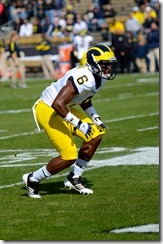 Ramon Taylor (right-Fuller)'s emergence last year shows he's probably got "it." This was a guy en route to be a pretty good find by Bill Lynch at Indiana and had the recruiting profile of a smaller Troy Woolfolk, mentioning good speed but some stiffness.
Ramon Taylor (right-Fuller)'s emergence last year shows he's probably got "it." This was a guy en route to be a pretty good find by Bill Lynch at Indiana and had the recruiting profile of a smaller Troy Woolfolk, mentioning good speed but some stiffness.
Courtney Avery is a guy who gets by on brains, replacing Grant Mason for people who don't remember our Stanford transfer so well as the prototype for a moderately talented, modestly sized, moderately successful corner who survives by intelligence. I read more into him getting supplanted by Taylor last year than losing his nickel job this spring to Dymonte Thomas; the former puts a cap Avery as "less than whatever Taylor is" while the latter I see as preserving cornerback depth and making the nickel more of a safety position.
Among the quick and little we've had Cass Tech's Delonte Hollowell and Terry Richardson on campus for some time now, and Jourdan Lewis will join them this fall. Lewis is about 2 inches taller than the other two and has a recruiting profile that's likewise higher. Still, a recap of the Tiny Techs from Richardson's recruiting profile last year:
2008: Boubacar Cissoko is a top 50 player who heads to Michigan. He doesn't play well, possibly because he's going a little loopy, then gets in a bunch of legal trouble and ends up in jail. 2009: Teric Jones may be a running back, may be a defensive back, is definitely really small, starts at RB, gets moved to corner, gets moved back to RB, eventually stops playing football. 2010: Dior Mathis is a top 250-type guy who heads off to Oregon, where he's appeared in five games so far. 2011: Delonte Holowell goes to Michigan, where he types all-caps tweets and sees a little time as a freshman.
Richardson got run over in the Spring Game by Rawls and needs some poundage to play. Hollowell seems to be fading, then the coaches let some hype on him slip out again, and he played well in the Spring. Ross Douglas, who's 5'10-176, was on hand this spring as well and didn't seem to do much.
The new mold is to go large and hope to get something at least as effective as James Rogers was in 2010, and hopefully stumble upon a Marlin Jackson somewhere out of Channing Stribling or Reon Dawson. From Dawson's recruiting profile yesterday:
It seems thematically appropriate to kick things off with one of three(!) 6'2" cornerbacks Michigan brought in, now that Dymonte Thomas is threatening to start at nickel. Since Dawson was a 1-for-1 replacement of Gareon Conley, another 6'2" player Michigan wanted to bring in at corner, Dawson is the most thematically appropriate player of the three. Michigan is going to be big, everywhere, and if their original plans are thwarted they'll go get a similarly big plan B, in fact the kind of Plan B that causes Ohio recruiting analysts to compare him to the plan A($).
Disagreement with Brian already lodged on what Thomas's at nickel truly signifies. Agreement with the coaches lodged on whether big corners are good idea. Lately the really swift and talented receivers haven't been signing with Big Ten teams. Purdue's dink-and-dunk system could be trouble for stiff and large corners but we'll barely ever play them under the new alignment. Our common opponents have been making do with tall guys who stretch the field. As anyone who's watched NFL teams try to contain Calvin Johnson every week can attest, the best strategy is a big corner who can muscle up on the outside and keep up with him deep, thus forcing the Lions to put Johnson in the slot where the safeties and linebackers can try to squeeze the rest of his catches down to minimal gains. The true matchup monsters won't be coming out of a Big Ten tunnel until NCAA enforcement stops being a joke or the SEC plays a bowl game up here, two things I doubt will happen before today's recruits have completed their degrees. If you can stop a Kenny Bell or Allen Robinson or properly deployed Kevonte Martin-Manley in this league, you'll do alright. if your corners can be strong run stoppers, picking off lead blockers and setting the edge, that means a lot against spread-to-run outfits.
And most importantly, here's Ohio State's 2012 wide receiver recruits:
Their 2013 guys are both slots. James Clark is 5'11/170, Corey Smith 6'0/170
Who's on the two-deep this fall could provide a lot of clarity.
The Shazorvacs will haunt my dreams a little bit...
Beyond that, though, did Walsh-era folks distinguish between field and boundary corners, or was it basically "you're defending an outside receiver, so whatevs"?
More like was editing HTTV stuff until late last night, got up at 4 to write this one this morning, and was running out of time after spending too long making SHAZORVACS
I see you are perpetuating the "horse playing football" argument with your strong safety evaluations.
is the least WR name of all-time.
it is the most "shaving lamb meat off of a giant meat skewer and onto a piece of flatbread" name ever, though.
or does it seem like Meyer isn't getting the great guys that everyone in Ohio seems to think he's getting? I see a few 5 stars, but specifically the OL/WR recruiting leaves much to be desired
Tripp was the strong safety, Vada was the free safety.
Yeah technically Welborne was the strong safety. But he was a fantastic cover guy (and built like one), and Michigan used him kinda like how modern quarters defenses use their Ed Reeds (and the Colts deployed Marlin as a nickel), bringing him down to the box, threatening blitzes sometimes, and having play robber zones, hence all the interceptions. If you ask me the 1989 defense was perhaps Lloyd Carr's best coaching job. We talk about these great defenses that people run nowadays and the things they do with safeties, and forget we had a pretty high-tech thing running around these parts.
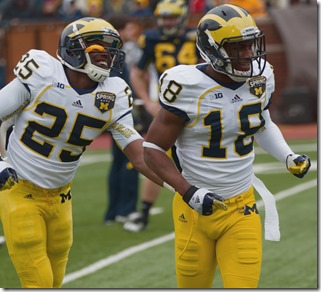
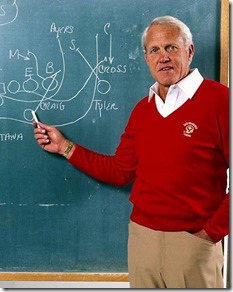
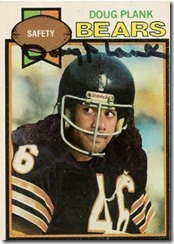
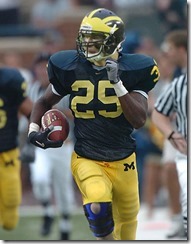
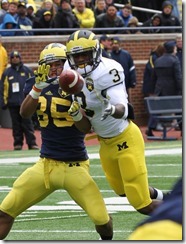
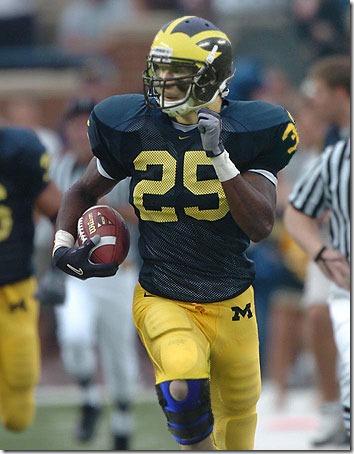
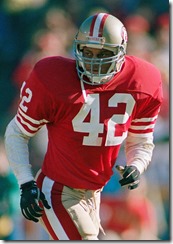
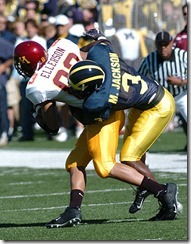
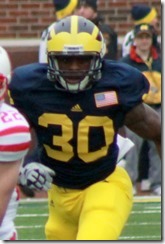

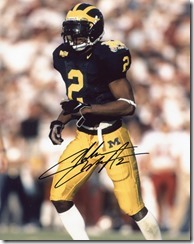
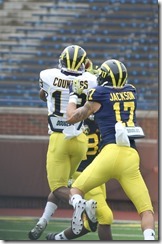
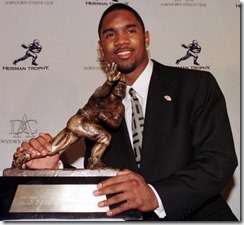

Comments